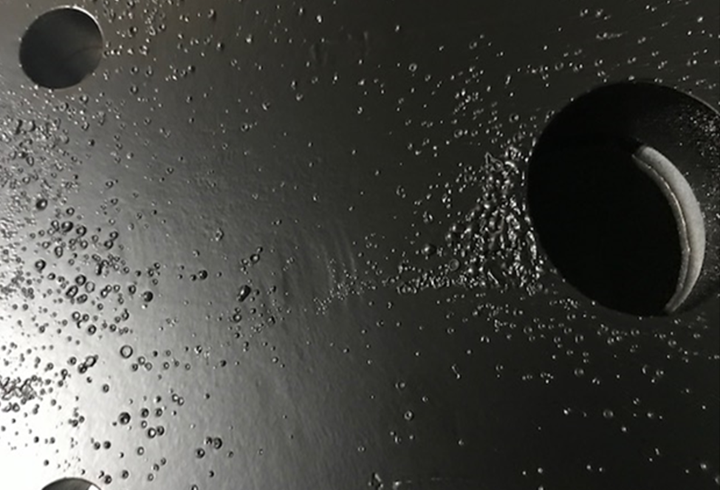Outgassing and Powder Coating Defects
Having trouble with bubbles forming during curing? Verney Denerville of TIGER Drylac discusses proper outgassing procedures.

Outgassing occurs when air and or gas trapped inside castings expands during the heating process. If not properly addressed prior to the coating process, trapped gasses can result in defects.
Photo Credit: TIGER Drylac
Q: We’re having trouble with bubbles forming during the curing process for powder coated parts. Do you have any recommendations?
A. There are several potential causes for powder coating defects, especially when dealing with various substrates that exhibit porosity. The defects you describe are often caused by a phenomenon known as outgassing.
Common substrates are iron, steel and aluminum — metals that tend to contain minute holes or voids. This porosity can lead to outgassing during the curing process after a part has been coated. In this instance, contaminants such as trapped gasses and air are released, ultimately causing defects in the coating.
Possible outgassing defect causes
1. Castings: Gasses can become trapped in the casting material during the pouring process of both sand and die castings. These gasses can be anything from entrapped air to gas formed during the cooling of the molten metal. When a powder coating is applied over the cast metal surface, defects from outgassing can occur.
2. Galvanized (Zinc Coated) Substrates: In galvanizing, the process of applying the zinc to the steel substrate produces gasses that can be entrapped within the porosity and later released during the curing process.
3. Surface Contamination: Contamination of the surface of the substrate prior to coating is another contributing factor to outgassing. Substances such as oil, grease and other foreign materials can vaporize during the curing cycle and cause outgassing defects.
4. Coating Thickness: When the film thickness is high, it can lead to outgassing during the cure cycle.
Mitigating trapped gasses
In order to prevent defects, gasses and impurities must be expelled from the substrate prior to powder coating. It is highly recommended that the substrate be subjected to an outgassing or de-gassing process as part of the preparation for the coating application. Failure to properly outgas the substrate can lead to issues such as bumps, bubbles and pinholes — defects that will certainly lead to intercoat adhesion loss and result in rework.
Proper outgassing procedures are as follows:
- Heat the substrate to a temperature at least 15°C (30°F) higher than the part metal temperature (PMT) based on the product tactical data sheet (TDS).
- Coat the part before it cools — reaching ambient temperature introduces the possibility of air re-entering the porosity of the substrate.
- Employ proper surface cleaning procedures — parts must be free of contaminants such as oil, grease and foreign substances.
- Make sure to keep the film thickness within recommended parameters on the powder coating technical data sheet (TDS).
If the surface cannot be satisfactorily degassed at the higher temperature, using a product that is specifically formulated to assist the outgassing process, such as TIGER Drylac Outgas Forgiving/OGF Primer, during the curing cycle can help.
Additional Steps
Products that can be dry blended to the powder sample at the customer site can further help in mitigating defects caused by outgassing. While it is impossible to eliminate outgassing, the objective is to be able to reduce rework and inter-coat adhesion issues. Performing proper degassing procedures, taking cleaning measures and following the proper steps can help you take control of outgassing and keep it from wreaking havoc with your parts.
About the Author

Denerville
Photo Credit: TIGER Drylac
Verney Denerville
Verney Denerville is an application field specialist with TIGER Drylac. Visit tiger-coatings.com.
Related Content
Understanding and Managing White Spots on Anodized Aluminum
Having trouble with spotting defects when anodizing? Taj Patel of Techevon LLC offers a helpful overview of the various causes of white spots and potential solutions.
Read More10 Anodizing Best Practices
Following this list of guidelines can help to increase the performance, cost effectiveness and quality for your anodizing operation.
Read MoreCorrosion Resistance Testing for Powder Coating
Salt spray can be useful to help compare different pretreatment methods and coatings but it does not tell us much about the corrosion resistance of a part over time in the field. Powder coating expert Rodger Talbert offers insights into how to get a better idea of how to improve a part’s corrosion resistance in the real world.
Read More3 Tests to Ensure Parts are Clean Prior to Plating
Making sure that all of the pre-processing fluids are removed prior to plating is not as simple as it seems. Rich Held of Haviland Products outlines three tests that can help verify that your parts are clean.
Read MoreRead Next
Preventing Corrosion in Small Areas
Powder coating expert Rodger Talbert discusses how to get proper cleaning and coverage in tight Faraday areas.
Read MoreColor and Quality in Powder Coating
Diverse and customized powder coating colors can give you a competitive edge.
Read MoreOver Curing Vs. Under Curing
Are defects in your powder-coated parts due to curing too long or not long enough? Verney Denerville of Tiger Drylac discusses the dangers of over- and under-curing and steps you can take to ensure a proper curing time for your parts.
Read More








.jpg;maxWidth=300;quality=90)












